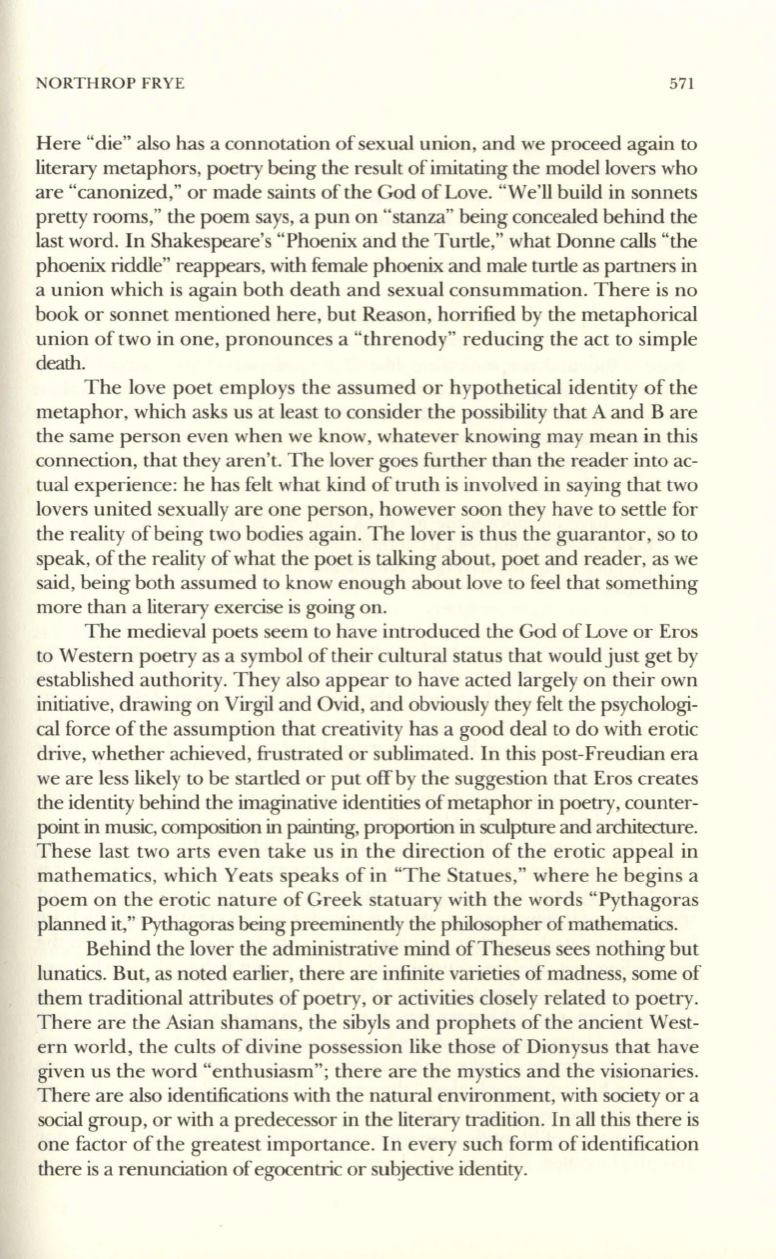
NORTHROP FRYE
571
Here "die" also has a connotation of sexual union, and we proceed again to
literary metaphors, poetry being the result of imitating the model lovers who
are "canonized," or made saints of the God of Love. "We'll build in sonnets
pretty rooms," the poem says, a pun on "stanza" being concealed behind the
last word.
In
Shakespeare's "Phoenix and the Turtle," what Donne calls "the
phoenix riddle" reappears, with female phoenix and male turtle as partners in
a union which is again both death and sexual consummation. There is no
book or sonnet mentioned here, but Reason, horrified by the metaphorical
union of two in one, pronounces a "threnody" reducing the act to simple
death.
The love poet employs the assumed or hypothetical identity of the
metaphor, which asks us at least to consider the possibility that A and Bare
the same person even when we know, whatever knowing may mean in this
connection, that they aren't. The lover goes further than the reader into ac–
tual experience: he has felt what kind of truth is involved in saying that two
lovers united sexually are one person, however soon they have to settle for
the reality of being two bodies again. The lover is thus the guarantor, so to
speak, of the reality of what the poet is talking about, poet and reader, as we
said, being both assumed to know enough about love to feel that something
more than a literary exercise is going on.
The medieval poets seem to have introduced the God of Love or Eros
to Western poetry as a symbol of their cultural status that would just get by
established authority. They also appear to have acted largely on their own
initiative, drawing on Virgil and Ovid, and obviously they felt the psychologi–
cal force of the assumption that creativity has a good deal to do with erotic
drive, whether achieved, frustrated or sublimated.
In
this post-Freudian era
we are less likely to be startled or put off by the suggestion that Eros creates
the identity behind the imaginative identities of metaphor in poetry, counter–
point in music, composition in painting, proportion in sculpture and architecture.
These last two arts even take us in the direction of the erotic appeal in
mathematics, which Yeats speaks of in "The Statues," where he begins a
poem on the erotic nature of Greek statuary with the words "Pythagoras
planned it," Pythagoras being preeminently the philosopher of mathematics.
Behind the lover the administrative mind of Theseus sees nothing but
lunatics. But, as noted earlier, there are infinjte varieties of madness, some of
them traditional attributes of poetry, or activities closely related to poetry.
There are the Asian shamans, the sibyls and prophets of the ancient West–
ern world, the cults of divine possession hke those of Dionysus that have
given us the word "enthusiasm"; there are the mystics and the visionaries.
There are also identifications with the natural environment, with society or a
social group, or with a predecessor in the literary tradjtion.
In
all this there is
one factor of the greatest importance.
In
every such form of identification
there is a renunciation ofegocentric or subjective identity.


